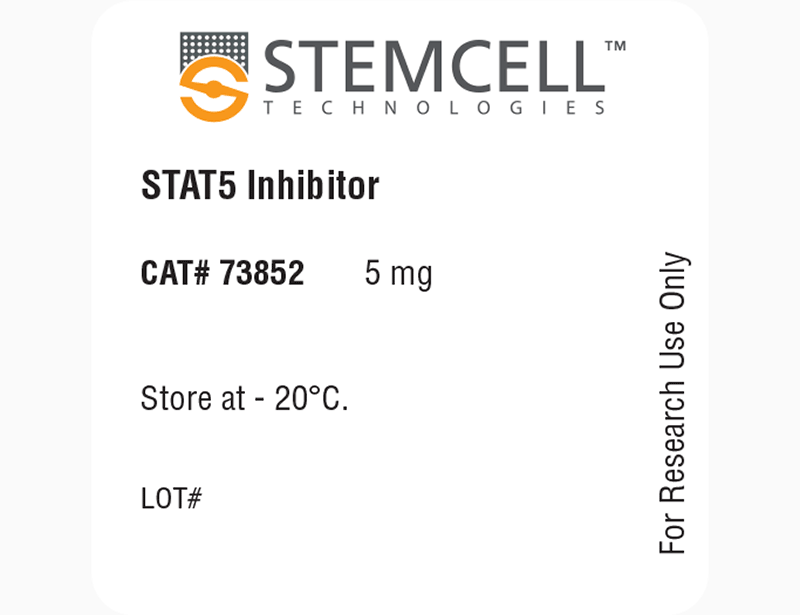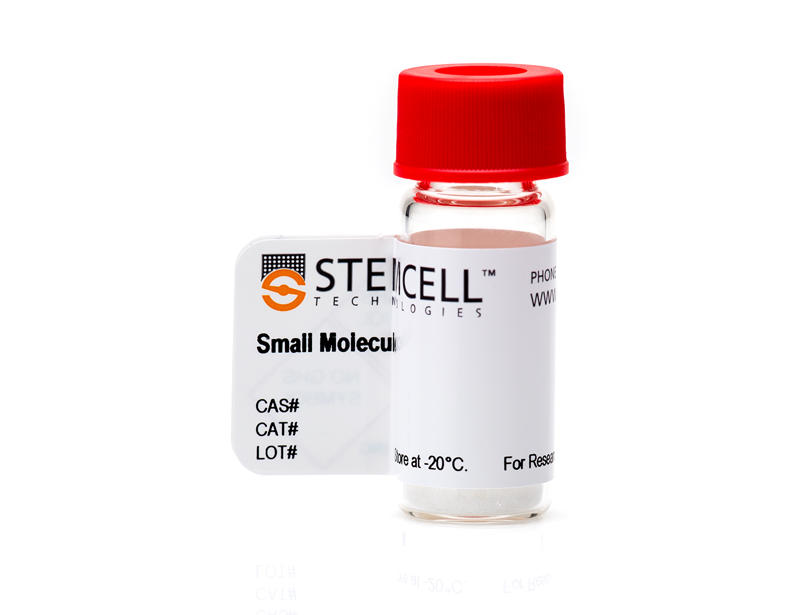概要
STAT5 Inhibitor is a cell-permeable, nonpetidic nicotinoyl hydrazone that specifically suppresses STAT5 (IC₅₀ = 47 µM) via binding to its SH2 domain. It shows reduced potency towards the SH2 domains of STAT1, STAT3, or LCK (Müller et al.).
IMMUNOLOGY
· Induces partial apoptosis of mature eosinophils at high concentrations (Schwartz et al.).
· Rescues IL-17 production in a proportion of restimulated TH17 clones (Zielinski et al.)
· Reduces growth of induced regulatory T cells (iTregs) in vitro (Betts et al.).
IMMUNOLOGY
· Induces partial apoptosis of mature eosinophils at high concentrations (Schwartz et al.).
· Rescues IL-17 production in a proportion of restimulated TH17 clones (Zielinski et al.)
· Reduces growth of induced regulatory T cells (iTregs) in vitro (Betts et al.).
技术资料
| Document Type | 产品名称 | Catalog # | Lot # | 语言 |
|---|---|---|---|---|
| Product Information Sheet | STAT5 Inhibitor | 73852 | All | English |
| Safety Data Sheet | STAT5 Inhibitor | 73852 | All | English |
数据及文献
Publications (4)
Blood 2015 JUN
Eosinophil-specific deletion of IκBα in mice reveals a critical role of NF-κB-induced Bcl-xL for inhibition of apoptosis.
Abstract
Abstract
Eosinophils are associated with type 2 immune responses to allergens and helminths. They release various proinflammatory mediators and toxic proteins on activation and are therefore considered proinflammatory effector cells. Eosinophilia is promoted by the cytokines interleukin (IL)-3, IL-5, and granulocyte macrophage-colony-stimulating factor (GM-CSF) and can result from enhanced de novo production or reduced apoptosis. In this study, we show that only IL-5 induces differentiation of eosinophils from bone marrow precursors, whereas IL-5, GM-CSF, and to a lesser extent IL-3 promote survival of mature eosinophils. The receptors for these cytokines use the common β chain, which serves as the main signaling unit linked to signal transducer and activator of transcription 5, p38 mitogen-activated protein kinase, and nuclear factor (NF)-κB pathways. Inhibition of NF-κB induced apoptosis of in vitro cultured eosinophils. Selective deletion of IκBα in vivo resulted in enhanced expression of Bcl-xL and reduced apoptosis during helminth infection. Retroviral overexpression of Bcl-xL promoted survival, whereas pharmacologic inhibition of Bcl-xL in murine or human eosinophils induced rapid apoptosis. These results suggest that therapeutic strategies targeting Bcl-xL in eosinophils could improve health conditions in allergic inflammatory diseases.
Journal of leukocyte biology 2014 FEB
STAT5 polarization promotes iTregs and suppresses human T-cell alloresponses while preserving CTL capacity.
Abstract
Abstract
Alloreactivity negatively influences outcomes of organ transplantation or HCT from allogeneic donors. Standard pharmacologic immune suppression impairs T-cell function and jeopardizes the beneficial reconstitution of Tregs. Murine transplantation models have shown that STAT3 is highly expressed in alloreactive T cells and may be therapeutically targeted. The influence and effects of STAT3 neutralization in human alloreactivity, however, remain to be elucidated. In this study, S3I-201, a selective small-molecule inhibitor of STAT3, suppressed human DC-allosensitized T-cell proliferation and abrogated Th17 responses. STAT3 blockade significantly enhanced the expansion of potent iTregs and permitted CD8(+) cytolytic effector function. Mechanistically, S3I-201 polarized the ratio of STAT phosphorylation in favor of STAT5 over STAT3 and also achieved a significant degree of Foxp3 demethylation among the iTregs. Conversely, selective impairment of STAT5 phosphorylation with CAS 285986-31-4 markedly reduced iTregs. STAT3 represents a relevant target for achieving control over human alloresponses, where its suppression facilitates STAT5-mediated iTreg growth and function.
Nature 2012 APR
Pathogen-induced human TH17 cells produce IFN-γ or IL-10 and are regulated by IL-1β.
Abstract
Abstract
IL-17-producing CD4+ T helper cells (TH17) have been extensively investigated in mouse models of autoimmunity. However, the requirements for differentiation and the properties of pathogen-induced human TH17 cells remain poorly defined. Using an approach that combines the in vitro priming of naive T cells with the ex vivo analysis of memory T cells, we describe here two types of human TH17 cells with distinct effector function and differentiation requirements. Candida albicans-specific TH17 cells produced IL-17 and IFN-γ, but no IL-10, whereas Staphylococcus aureus-specific TH17 cells produced IL-17 and could produce IL-10 upon restimulation. IL-6, IL-23 and IL-1β contributed to TH17 differentiation induced by both pathogens, but IL-1β was essential in C. albicans-induced TH17 differentiation to counteract the inhibitory activity of IL-12 and to prime IL-17/IFN-γ double-producing cells. In addition, IL-1β inhibited IL-10 production in differentiating and in memory TH17 cells, whereas blockade of IL-1β in vivo led to increased IL-10 production by memory TH17 cells. We also show that, after restimulation, TH17 cells transiently downregulated IL-17 production through a mechanism that involved IL-2-induced activation of STAT5 and decreased expression of ROR-γt. Taken together these findings demonstrate that by eliciting different cytokines C. albicans and S. aureus prime TH17 cells that produce either IFN-γ or IL-10, and identify IL-1β and IL-2 as pro- and anti-inflammatory regulators of TH17 cells both at priming and in the effector phase.
Chembiochem : a European journal of chemical biology 2008 MAR
Discovery of chromone-based inhibitors of the transcription factor STAT5.
Abstract

 网站首页
网站首页




